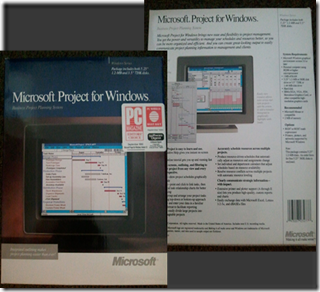Meet the Project 1.0 Creators
 A little while ago the Project development team had the honor of meeting our makers so to say - Brian MacDonald and Jeff Lill. They're the original creators of the first version of Project for Windows which was released in 1990.
A little while ago the Project development team had the honor of meeting our makers so to say - Brian MacDonald and Jeff Lill. They're the original creators of the first version of Project for Windows which was released in 1990.
They started as two local kids who grew up just a few miles from the Microsoft campus. In high school they thought it was cool how you could program little LED lights to go on and off. This fascination inspired their future in software development.
They spent some time attending the University of Washington and while they were there built a spell checker app, Corrector. Unfortunately it was the third spell checker app to the market and while InfoWorld rated it the best in the industry, they only sold 24 copies. Brian thanks his good spelling today though to having to manually enter the entire dictionary. Jeff even did some internships with Microsoft since they needed money to finance their company.
After the spell checker app, they started working on a spreadsheet product for Macs called Crunch. Shortly after that, Microsoft came out with Excel and in Brian's words "really just crunched 'Crunch' ". At this time they had a lot of connections into Microsoft from Jeff’s internships and Brian's wife working there. They were at a party with Bill Gates and he mentioned they should stop competing and start working together. Microsoft was trying to recruit developers to make GUI (graphical user interface) apps for this new platform called Windows. They already had a spreadsheet and word processor but were looking for developers to create a database application (which would go on to be Access) and a project management application. Brian and Jeff chose the latter.
While Brian and Jeff had a lot of passion around software, they didn't have much project management expertise. As Jeff said though, they were arrogant enough to know they could do it. So they dove in and looked at competitors, did a bunch of customer interviews including with another local company, Boeing, read project management books and attended conferences. It was actually while they were on a site visit to Boeing that a light bulb went off and they came to the decision that they wanted to build a toolkit that had a broad enough appeal that anyone could use it for project management. At the time, most project management applications were built by consultants and the software would back up the methodology that the consultant was selling. Most companies though already had methodologies in place and just wanted software to support it. This decision turned out to be a pivotal one and something we still strongly believe to be correct today. In Project 2010, you’ll see that you can manage projects how you want to manage them.
How does it feel that people are still using the tool you built today for huge projects totaling billions of dollars?
It feels great! We had always hoped that would be the case. - Jeff
Anything about people's reactions to it surprise you?
Right around the time the second version of Project was coming out, Windows started to just explode in popularity and along with it any software that ran on Windows. We initially saw our audience as people who had "Project Manager" in their title but found that the product had a much broader appeal. People were using it to create schedules/Gantt charts to help show their management/team that they had their acts together and were on top of things. – Brian
That was very exciting for them and helped the product really take off. They also thank this success to their initial goal of being a toolkit instead of specific solution. This is why features such as the ability to re-title columns were available back in the original release.
What kinds of improvements did the second version of Project for Windows have over the first?
Print preview, support for macros, and improvements to the leveling algorithm were some of the top ones.
Yes, leveling was in v1. According to Jeff - "All the software solutions had it and all struggled with making it work how humans would expect". We are still trying to make this easier today by adding features like change highlighting in Project 2007 and the Team Planner in Project 2010.
What do you think of the current version of Project?
It looks great. A lot looks familiar with the overall user interface but it definitely looks more modern (they were happy to hear that we now have more than 16 colors). Per the timeline view, that was what we were trying to achieve with the Gantt chart (sharing the schedule with stakeholders) but has an even broader appeal. - Brian
Brian went on then to create Outlook which originally started out with the goal of being a task management application. It was only during coding and after much debate that they decided to add email support to it. We think they made the right decision. Jeff worked on Project a bit longer and then went on to do Team Manager. Today they both work in the Bing organization.
Some fun facts:
· There isn't a Microsoft Project 2.0 because someone else had copyrighted Project 2.0
· Bill Gates tried to convince them to re-write Project in BASIC and they said no.
· The last bug fixed for Project 1.0 for Windows was around supporting the Gantt Chart view with the Task Form.
In short, I would like to thank Brian and Jeff for creating this great product that so many of us use every day and rely on to accomplish a wide range of projects.